OR/19/038 Results: Difference between revisions
m (1 revision imported) |
No edit summary |
||
| Line 58: | Line 58: | ||
<div><ul> | <div><ul> | ||
<li style="display: inline-block;"> [[File:OR19038fig6.jpg|thumb|center|365px| '''Figure 6''' Hazard curves for PGA (first column), 0.2 s SA (second column) and 1.0 s SA (third column) for the source model of the UK computed using M3C (black solid lines) and OpenQuake (red solid lines), together with their relative difference from Equation 3 (dashed lines). The hazard calculations were performed for various GMPEs: BSSA14 (Boore et al., 2014<ref name="Boore 2014"></ref>), AKK13 (Akkar et al., 2013<ref name="Akkar 2013"></ref>), ASK14 (Abrahamson et al., 2014<ref name="Abrahamson 2014">ABRAHAMSON, N A, SILVA, W, and KAMAI, R. 2014. Summary of the ASK14 ground-motion relation for active crustal regions. ''Earthquake Spectra'', Vol. 30, 1025–1055. </ref>), and CY14 (Chiou and Youngs, 2014<ref name="Chiou 2014">CHIOU, B, and YOUNGS, R R. 2014. Update of the Chiou and Youngs NGA model for the average horizontal component of peak ground motion and response spectra. ''Earthquake Spectra'', Vol. 30, 1117–1153. </ref>). ]] </li> | <li style="display: inline-block;"> [[File:OR19038fig6.jpg|thumb|center|365px| '''Figure 6''' Hazard curves for PGA (first column), 0.2 s SA (second column) and 1.0 s SA (third column) for the source model of the UK computed using M3C (black solid lines) and OpenQuake (red solid lines), together with their relative difference from Equation 3 (dashed lines). The hazard calculations were performed for various GMPEs: BSSA14 (Boore et al., 2014<ref name="Boore 2014"></ref>), AKK13 (Akkar et al., 2013<ref name="Akkar 2013"></ref>), ASK14 (Abrahamson et al., 2014<ref name="Abrahamson 2014">ABRAHAMSON, N A, SILVA, W, and KAMAI, R. 2014. Summary of the ASK14 ground-motion relation for active crustal regions. ''Earthquake Spectra'', Vol. 30, 1025–1055. </ref>), and CY14 (Chiou and Youngs, 2014<ref name="Chiou 2014">CHIOU, B, and YOUNGS, R R. 2014. Update of the Chiou and Youngs NGA model for the average horizontal component of peak ground motion and response spectra. ''Earthquake Spectra'', Vol. 30, 1117–1153. </ref>). ]] </li> | ||
<li style="display: inline-block;"> [[File:OR19038fig7.jpg|thumb|center|420px| '''Figure 7''' Hazard curves (solid lines) for PGA, 0.2 s SA and 1.0 s SA for the source model of the UK at the site, together with the corresponding relative difference (dashed lines). The black, blue, and green lines are the hazard curve computed using M3C, using the magnitude-length scaling relationship of Wells and Coppersmith (1994)<ref name="Wells 1994"></ref> for ‘Subsurface rupture length’ (indicated as WC94, SSRL), ‘Surface rupture length’ (indicated as WC94, SRL) and Leonard (2010)<ref name="Leonard 2010">LEONARD, M. 2010. Earthquake fault scaling: Self-consistent relating of rupture length, width, average displacement, and moment release. ''Bulletin of the Seismological Society of America'', Vol. 100, 1971–1988. </ref> (indicated as LEO10), respectively. The red hazard curves were computed by OpenQuake, using the magnitude-area scaling relationship of Wells and Coppersmith (1994)<ref name="Wells 1994"> | <li style="display: inline-block;"> [[File:OR19038fig7.jpg|thumb|center|420px| '''Figure 7''' Hazard curves (solid lines) for PGA, 0.2 s SA and 1.0 s SA for the source model of the UK at the site, together with the corresponding relative difference (dashed lines). The black, blue, and green lines are the hazard curve computed using M3C, using the magnitude-length scaling relationship of Wells and Coppersmith (1994)<ref name="Wells 1994"></ref> for ‘Subsurface rupture length’ (indicated as WC94, SSRL), ‘Surface rupture length’ (indicated as WC94, SRL) and Leonard (2010)<ref name="Leonard 2010">LEONARD, M. 2010. Earthquake fault scaling: Self-consistent relating of rupture length, width, average displacement, and moment release. ''Bulletin of the Seismological Society of America'', Vol. 100, 1971–1988. </ref> (indicated as LEO10), respectively. The red hazard curves were computed by OpenQuake, using the magnitude-area scaling relationship of Wells and Coppersmith (1994)<ref name="Wells 1994"></ref>. ]] </li> | ||
</ul></div> | </ul></div> | ||
</center> | </center> | ||
Revision as of 11:04, 2 December 2019
| Mosca, I. 2019. Comparing seismic hazard software packages: M3C vs. OpenQuake. British Geological Survey Internal Report, OR/19/038. |
This section presents the comparison of the hazard calculations for the PEER validation exercises of Thomas et al. (2010)[1] and for the UK source model.
Peer validation tests
I used the exercises developed within the PEER Centre’s Lifelines Program (Thomas et al., 2010[1]) as a first step to validate the computer program M3C. This set of exercises is designed to check how the codes implement fundamental steps of PSHA, e.g. implementation of the magnitude-frequency distribution, modelling of the area sources and ruptures on the fault planes. For this reason, they use a single source typology and no epistemic uncertainty. Below, I show the results for Set 1 Case 5 (referred as to S1C05) and Set 1 Case 10 (referred as to S1C10). In this comparison, I did not consider OpenQuake because Pagani et al. (2014)[2] show the results of the PEER validation exercises using OpenQuake.
S1C05 tests a vertical strike-slip fault with uniform slip, b-value of 0.9 and an activity rate of 3.129 for a minimum magnitude of 0.0 Mw, and the truncated exponential magnitude distribution between 5.0 and 6.5 Mw. Figure 4a shows the configuration of the seismic fault source and four sites. The magnitude-length scaling relationship is log L = 0.5 Mw–1.85. The length of the fault is 25.0 km and the width of the fault plane is 12.0 km. This test assumes that the fault rupture is smaller than the entire fault length. The GMPE used for the hazard calculations is Sadigh et al. (1997)[3] for rock soil conditions and the ground motion truncation is 0σ. I simulated 1 000 000 earthquake catalogues, each 100 years long. The total number of 100 000 000 years is sufficient to resolve the hazard accurately for the annual probability of exceedance (APoE) of 10-6. Figure 4b–4e shows the PGA hazard curves computed by M3C and the comparison with the solutions in Appendix A of Thomas et al. (2010)[1] that are the mean values of the distribution estimates from the software packages considered in Thomas et al. (2010)[1]. The comparison is very good when the site is outside the fault, whereas there are some discrepancies between the hazard results from M3C and the solution of Thomas et al. (2010)[1] when the site is located along the fault. It is worth underlining that this is a rare case and a site next to the fault, but not along the fault, is more common.
S1C10 considers a uniform area source with a truncated exponential magnitude distribution between 5.0 and 6.5 Mw, b-value of 0.9 and activity rate of -1.403 for a minimum magnitude of 5.0 Mw, and fixed the focal depth of 5 km. The sites are situated in four locations (Figure 5a). As in Test S1C05, the GMPE for this exercise is Sadigh et al. (1997)[3] for rock soil conditions and the ground motion truncation is 0σ. I simulated the same number of catalogues as for S1C5, 1 000 000 catalogues, each 100 years long. Figures 5b–5e shows an excellent agreement between M3C and the hazard curves in Appendix A of Thomas et al. (2010)[1]. The solutions in Thomas et al. (2010)[1] are the mean values of the distribution estimates from the software packages considered.
-
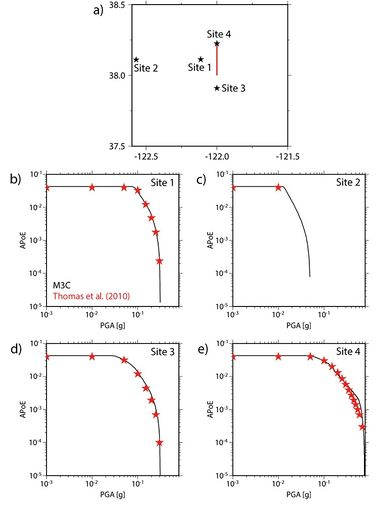
Figure 4a Source-to-site configuration of the validation test for the fault source in S1C05 of Thomas et al. (2010); and b–e Comparison of the hazard curves, expressed as annual probability of exceedance (APoE), for PGA computed by M3C (black solid lines) and the PGA hazard curves in Thomas et al. (2010)[1] (red stars). -

Figure 5a Source-to-site configuration of the validation test for the areal source in S1C10 of Thomas et al. (2010); b–e comparison of the hazard curves for PGA computed by M3C (black solid lines) and the PGA hazard curves in Thomas et al. (2010)[1] (red stars).
Comparing results using the UK national seismic hazard model
To test a real source model with a complex source-site configuration and finite rupture modelling, I apply the UK source model described in Section 3. I compare hazard results produced by OpenQuake and M3C.
I used M3C to generate 1 000 000 synthetic catalogues each 100 years for the source zone model of the UK. 100 000 000 years of data is enough to resolve long return periods, up to 10 000 years. In the following set of tests, I used OpenQuake to implement the Cornell-McGuire PSHA and therefore it did not simulate synthetic catalogues. To model the fault rupture for M3C, I used the magnitude-length scaling relationship of Wells and Coppersmith (1994)[4] for strike-slip faulting and ‘Subsurface rupture length’ Mw = 1.49 logL + 4.33 (referred here as to WC94/SSRL) and an aspect ratio equal to 1.0. OpenQuake uses the magnitude-area scaling relationship of Wells and Coppersmith (1994)[4] for strike-slip faulting, i.e. log A = -3.42 + 0.90 Mw, and the aspect ratio of 1.0. In all tests below, except Test 1, I used the GMPE of Boore et al. (2014)[5].
M3C takes around 5 minutes to generate 1 000 000 synthetic catalogues and compute the hazard for a site, using a single processor, whereas OpenQuake takes about 7.4 minutes to perform the Cornell-McGuire PSHA using eight processors. Although the computational time of M3C and OpenQuake to make a hazard calculation is similar (5.0 versus 7.4 min), M3C uses only one processor, whereas OpenQuake uses eight processors. The performance of OpenQuake improves significantly as the number of available processors increases.
To make a quantitative evaluation of the difference between the results, I made a number of tests and estimated the relative difference D between pairs of annual probability of exceedance with the same ground motion parameter:
Δ = (APoE2 – APoE1)/APoE1 (3)
Where APoE1 and APoE2 are the annual probability of exceedance from M3C and OpenQuake, respectively. This function varies between -1.0 and 1.0. When Δ=0.0, the hazard curves are identical and as the absolute values of Δ increases, the difference between the hazard curves increases. It is difficult to assess what an acceptable difference is when comparing results from different codes. However, McGuire (2012)[6] and USNRC (2012)[7] suggest that for a site-specific PSHA, a change in APoE of less than ± 25% may not be significant when APoE<10-4, and the tolerance increases to ± 35% for APoE>10-6 (Bommer et al., 2013[8]).
Test 1: GMPEs
In the first test, I tested various GMPEs to check whether the implementation of the ground motion models in M3C and OpenQuake provides identical results. The GMPEs selected for this test were Akkar et al. (2013)[9], Boore et al. (2014)[5], Abrahamson et al. (2014)[10], and Chiou and Youngs (2014)[11]. The hazard curves for the first test are plotted in Figure 6 for peak ground acceleration (PGA) and spectral acceleration (SA) at a period of 0.2 s and 1.0 s, examples of a short and long period acceleration, respectively. The hazard curves computed by M3C consist of 1000 points and the curves calculated by OpenQuake consist of 80 points for the same range of the ground motion parameter. This means that the spacing used by the codes to compute the hazard curves is different. As a result, the trend of D is irregular because I used only the common points. The agreement between M3C and OpenQuake is very good and the Δ values are between -0.3 and 0.1 for PGA, between -0.1 and 0.1 for 0.2 s SA and between 0.3 and 0.1 for 1.0 s SA (Figure 6). This means that the difference between the curves is between -30% and 10% for APoE ≤10-5 and therefore it is not significant based on the acceptable tolerance of McGuire (2012)[6] and USNRC (2012)[7]. The GMPEs that result in the largest difference between the software packages are Chiou and Youngs (2014)[11] and Campbell and Bozognia (2014[12]; not shown in Figure 6) because they both use the rupture distance (Rrup), rather than the Joyner-Boore distance (Rjb). Bommer et al. (2013)[8] find that GMPE models based on Rrup are more sensitive to the fault rupture modelling within areal sources than GMPEs based on Rjb. This conclusion is in agreement with the findings of the present report where differences in the hazard calculations between the software packages increase when GMPEs based on the Rrup, rather than on Rjb, are selected.
Test 2: Magnitude scaling relationship
The second test evaluates the influence of the magnitude scaling relationship on the hazard curves if I use a magnitude-length scaling relationship different from WC94/SSRL for M3C. I tested the magnitude-length scaling relationship of both Wells and Coppersmith (1994)[4] for ‘Surface rupture length’ (referred here as to WC94/SRL) and Leonard (2010)[13] (referred here as to LEO10). Figure 7 shows clearly that WC94/SSRL and LEO10 provide the most similar results with the hazard curves computed using OpenQuake. The corresponding Δ values are very small for APoE >10-5. The hazard curves from WC94/SRL are slightly different from those computed by OpenQuake.
Test 3: Treatment of epistemic uncertainty in the recurrence statistics
In the third test, I checked how much the treatment of the epistemic uncertainty in the recurrence parameters influences the hazard curves. I ran M3C using the source model where the recurrence parameters of the source zones are given by the full pdf, i.e. 25 values for a and b; whereas, I run OpenQuake using the source model where the recurrence parameters of the zones are given by the most likely values in the pdf (see Section 3). The results are shown in Figure 8. The differences (up to 30%) between the hazard curves, especially for 1.0 s SA, are explained by the fact that the source models are not identical. For this reason, I tested the full pdf for the recurrence parameters of the source models using the two codes. To avoid a lengthy input file for OpenQuake and a long computational time, I restricted this test to the source zones EC1 and M123 that are adjacent to the site. In this case, the hazard curves are almost identical and the relative difference is between 0 and -15% (Figure 9).
Test 4: The effect of the site
In the fourth test, I used various sites (see Figure 2). The comparison between the hazard curves computed by M3C and OpenQuake is good as shown by the trend of Δ that is between -0.10 and 0.10, i.e. |Δ| <10 % (Figure 10). The discrepancy between the hazard curves is slightly higher at the site in Snowdonia (Wales). This difference is because the site is included in a source zone that is too small to be properly resolved by OpenQuake.
Test 5: Monte Carlo-based PSHA
In the last test, I run OpenQuake for Monte Carlo-based PSHA and therefore generating a set of 1 000 000 stochastic events for the source model consisting of the zones EC1 and M123 only. This is because this approach is computationally very intensive and is not recommended for investigating large regions (GEM, 2019[14]). Indeed, it took around two days to generate 1 000 000 stochastic events, and four days to generate 10 000 000 stochastic events, and compute the corresponding hazard curves using eight processors. The hazard curves for M3C and OpenQuake are relatively similar. At large (>0.01) APoE, the differences between the two curves are significant, up to Δ=0.80. I have not investigated the reason for this large discrepancy due to the long computational time required to OpenQuake to run a large number of stochastic events using only eight processors.
Hazard maps
Figure 12 shows the hazard map for PGA with a return period of 475 years (i.e. 10% exceedance probability in 50 years) in the UK using M3C and OpenQuake. The grid spacing of the maps is 0.25° for M3C and 20.0 km for OpenQuake, covering the area between 49° and 61°N latitude and -8° and 4°E longitude. I used the GMPE of Boore et al (2014)[5]. There is a satisfactory agreement between the two maps, at least from a visual inspection, because the main features of seismic hazard in the UK are displayed in both maps (e.g. high PGA in the Viking Graben and in the region of Snowdonia). The computation of the relative difference between the maps is not straightforward because of the different size of the grid points. I used only the grid points with latitude and longitude such that:
| Latitude (M3C) — Latitude (OQ) |≤0.13º,
| Longitude (M3C) — Longitude (OQ) |≤0.13º.
When I quantify the relative difference between the maps, the larger, absolute values of D (up to ± 0.5) correspond to the regions with low levels of seismicity that were excluded by the source model.
-
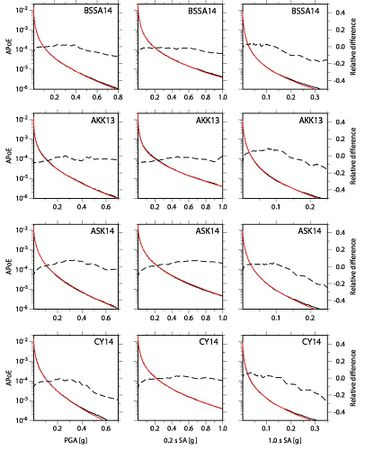
Figure 6 Hazard curves for PGA (first column), 0.2 s SA (second column) and 1.0 s SA (third column) for the source model of the UK computed using M3C (black solid lines) and OpenQuake (red solid lines), together with their relative difference from Equation 3 (dashed lines). The hazard calculations were performed for various GMPEs: BSSA14 (Boore et al., 2014[5]), AKK13 (Akkar et al., 2013[9]), ASK14 (Abrahamson et al., 2014[10]), and CY14 (Chiou and Youngs, 2014[11]). -

Figure 7 Hazard curves (solid lines) for PGA, 0.2 s SA and 1.0 s SA for the source model of the UK at the site, together with the corresponding relative difference (dashed lines). The black, blue, and green lines are the hazard curve computed using M3C, using the magnitude-length scaling relationship of Wells and Coppersmith (1994)[4] for ‘Subsurface rupture length’ (indicated as WC94, SSRL), ‘Surface rupture length’ (indicated as WC94, SRL) and Leonard (2010)[13] (indicated as LEO10), respectively. The red hazard curves were computed by OpenQuake, using the magnitude-area scaling relationship of Wells and Coppersmith (1994)[4].
-
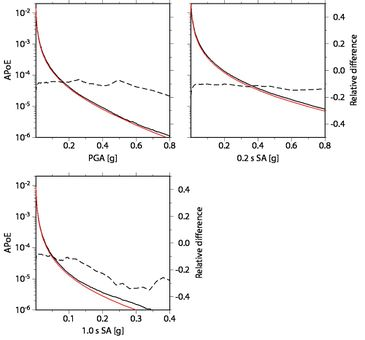
Figure 8 Hazard curves for PGA, 0.2 s SA and 1.0 s SA for the source model of the UK at the site using M3C (black lines) and OpenQuake (red lines), together with their relative difference (dashed lines). The activity rate and the b-value in the source zone model used by M3C are given by a pdf for each zone. The recurrence parameters in the source zone model used by OpenQuake are given by one value that is the most likely value in the pdf. -
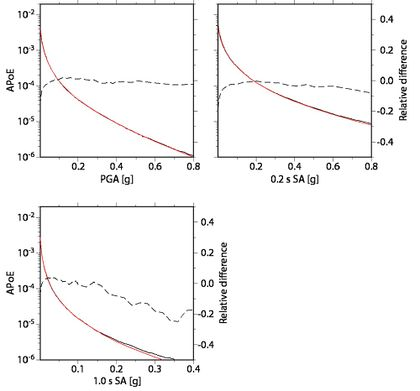
Figure 9 Hazard curves for PGA, 0.2 s SA and 1.0 s SA for two source zones of the UK source model at the site using M3C (black lines) and OpenQuake (red lines), together with their relative difference (dashed lines). The source model consists of two source zones and their activity rates and the b-values are given by the pdf for each zone.
-

Figure 10 Hazard curves for PGA (first column), 0.2 s SA (second column) and 1.0 s SA (third column) for the source model of the UK computed using M3C (black solid lines) and OpenQuake (red solid lines), together with their relative difference from Equation 3 (dashed lines). The hazard calculations were performed for various sites (see Figure 2). -

Figure 11 Hazard curves (solid lines) for PGA, 0.2 s SA and 1.0 s SA for the source model of the UK at the site, together with the corresponding relative difference (dashed lines). The black lines are the hazard curve computed by M3C. The red and green hazard curves were computed by OpenQuake, using 1,000 000 and 10 000 000 stochastic events, respectively. The source model consists of two source zone.
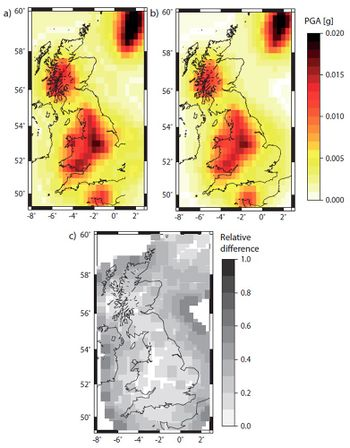
References
- ↑ 1.0 1.1 1.2 1.3 1.4 1.5 1.6 1.7 1.8 THOMAS, P, WANG I, and ABRAHAMSON, N N. 2010. Verification of probabilistic seismic hazard analysis computer programs. PEER Report 2010/106 (College of Engineering, University of California, Berkely).
- ↑ PAGANI, M, MONELLI, D, WEATHERILL, G, DANCIU, L, CROWLEY, H, SILVA, V, HENSHAW, P, NASTASI, M, PANZERI, L, and VIGANÒ, D. 2014. OpenQuake engine: An open hazard (and risk) software for Global Earthquake Model. Seismological Research Letters, Vol. 85, 692–702.
- ↑ 3.0 3.1 SADIGH, K, CHANG, C-Y, EGAN, J A, MAKDISI, F, and YOUNGS, R R. 1997. Attenuation relationships for shallow crustal earthquakes based on California strong motion data. Seismological Research Letters, Vol. 68, 180–189.
- ↑ 4.0 4.1 4.2 4.3 4.4 WELLS, D L, and COPPERSMITH, K J. 1994. New empirical relationships among magnitude, rupture length, rupture width, rupture area, and surface displacement. Bulletin of the Seismological Society of America, Vol. 84, 974–1002.
- ↑ 5.0 5.1 5.2 5.3 5.4 BOORE, D, STEWART, J, SEYHAN, E, and ATKINSON, G M. 2014. NGA-West2 equations for predicting PGA, PGV, and 5% damped PSA for shallow crustal earthquakes. Earthquake Spectra, Vol. 30, 1057–1085.
- ↑ 6.0 6.1 MCGUIRE, R K. 2012. Precision of seismic hazard evaluations in Central and Eastern North America. 15th World Conference of Earthquake Engineering, Lisboa.
- ↑ 7.0 7.1 USNRC. 2012. Central and Eastern United States seismic source characterization for nuclear facilities. U.S. Nuclear Regulatory Commission (Washington DC, US).
- ↑ 8.0 8.1 BOMMER, JJ, STRASSER, F O, PAGANI, M, and MONELLI, D. 2013. Quality assurance for logic-tree implementation in probabilistic seismic-hazard analysis for nuclear applications: a practical example. Seismological Research Letters, Vol. 84, 938–945. Cite error: Invalid
<ref>tag; name "Bommer 2013" defined multiple times with different content - ↑ 9.0 9.1 AKKAR, S, SANDIKKAYA, M A, and BOMMER, J J. 2013. Empirical ground-motion models for point- and extended-source crustal earthquake scenarios in Europe and the Middle East. Bulletin of Earthquake Engineering, DOI: 10.1007/s10518-10013-19416-10514.
- ↑ 10.0 10.1 ABRAHAMSON, N A, SILVA, W, and KAMAI, R. 2014. Summary of the ASK14 ground-motion relation for active crustal regions. Earthquake Spectra, Vol. 30, 1025–1055.
- ↑ 11.0 11.1 11.2 CHIOU, B, and YOUNGS, R R. 2014. Update of the Chiou and Youngs NGA model for the average horizontal component of peak ground motion and response spectra. Earthquake Spectra, Vol. 30, 1117–1153.
- ↑ BOZORGNIA, Y, ABRAHAMSON, N A, ATIK, L, ANCHETA, T, ATKINSON, G M, BAKER, J, BALTAY, A, BOORE, D, CAMPBELL, K, CHIOU, B, DARRAGH, R, DAY, S, DONAHUE, J, GRAVES, R, GREGOR, N, HANKS, T, IDRISS, I, KAMAI, R, KISHIDA, T, KOTTKE, A, MAHIN, S, REZAEIAN, S, ROWSHANDEL, B, SEYHAN, E, SHAHI, S, SHANTZ, T, SILVA, W, SPUDICH, P, STEWART, J, WATSON-LAMPREY, J, WOODDELL, K, and YOUNGS, R R. 2014. NGA-West2 Research Project. Earthquake Spectra, Vol. 30, 973–987.
- ↑ 13.0 13.1 LEONARD, M. 2010. Earthquake fault scaling: Self-consistent relating of rupture length, width, average displacement, and moment release. Bulletin of the Seismological Society of America, Vol. 100, 1971–1988.
- ↑ GEM. 2019. The OpenQuake-engine User Manual. Global Earthquake Model (GEM) OpenQuake Manual for Engine version 3.0.1. doi: 10.13117/GEM.OPENQUAKE.MAN.ENGINE.3.5.0.